|
|
 发表于 13-12-2007 11:58 PM
|
显示全部楼层
发表于 13-12-2007 11:58 PM
|
显示全部楼层
原帖由 蓝袍术士 于 13-12-2007 11:46 PM 发表 
耶稣讲道时,当然要引用犹太人都明白的旧约啊。引用本来就是为了说明或者加强说服力,如果引用一些大家都不懂的,那又有什么意思呢,嘻嘻。 ...
耶稣是神子,引用旧约应该是正常的。 |
|
|
|
|
|
|
|
|
|
|
|
 发表于 14-12-2007 12:02 AM
|
显示全部楼层
发表于 14-12-2007 12:02 AM
|
显示全部楼层
回复 #40 mahalwin 的帖子
yerr。。。感觉很暧昧@_@ ~ choi choi choi  |
|
|
|
|
|
|
|
|
|
|
|
 发表于 14-12-2007 12:09 AM
|
显示全部楼层
发表于 14-12-2007 12:09 AM
|
显示全部楼层
在福音书里JESUS有教导门徒作了一个祈祷
但是怎么看都不像学过佛的人讲的。。。 |
|
|
|
|
|
|
|
|
|
|
|
 发表于 14-12-2007 12:11 AM
|
显示全部楼层
发表于 14-12-2007 12:11 AM
|
显示全部楼层
|
|
|
|
|
|
|
|
|
|
|
 发表于 14-12-2007 12:12 AM
|
显示全部楼层
发表于 14-12-2007 12:12 AM
|
显示全部楼层
|
|
|
|
|
|
|
|
|
|
|
 发表于 14-12-2007 12:14 AM
|
显示全部楼层
发表于 14-12-2007 12:14 AM
|
显示全部楼层
|
|
|
|
|
|
|
|
|
|
|
 发表于 14-12-2007 12:16 AM
|
显示全部楼层
发表于 14-12-2007 12:16 AM
|
显示全部楼层
回复 #44 mahalwin 的帖子
|
KALI神?在HINDUISM里面听说很严肃很凶的,拜她的人不能在外面搞女人,行为要很好。。。不然后果好像很惨。。。听朋友说的。。。 |
|
|
|
|
|
|
|
|
|
|
|
 发表于 14-12-2007 12:17 AM
|
显示全部楼层
发表于 14-12-2007 12:17 AM
|
显示全部楼层
回复 #45 mahalwin 的帖子
对。。。WALAO~ 你这样也记得。。。所以我嘛讲。。。佛教徒不会罗。。。 |
|
|
|
|
|
|
|
|
|
|
|
 发表于 14-12-2007 12:17 AM
|
显示全部楼层
发表于 14-12-2007 12:17 AM
|
显示全部楼层
原帖由 mahalwin 于 14-12-2007 12:11 AM 发表 
http://www.rijksmuseum.nl/images/aria/ak/org/ak-mak-232a.org?aria/maxwidth_288
These two temple guards, Nandishvara and Mahakala, belong together. They once kept watch over a Hindu temple dedica ...
师兄好厉害啊。呵呵
或许我们讲的是不同的mahakala... |
|
|
|
|
|
|
|
|
|
|
|
 发表于 14-12-2007 12:20 AM
|
显示全部楼层
发表于 14-12-2007 12:20 AM
|
显示全部楼层
|
|
|
|
|
|
|
|
|
|
|
 发表于 14-12-2007 12:22 AM
|
显示全部楼层
发表于 14-12-2007 12:22 AM
|
显示全部楼层
原帖由 蓝袍术士 于 14-12-2007 12:17 AM 发表 
师兄好厉害啊。呵呵
或许我们讲的是不同的mahakala...
可能是一样的。。。我一直认为印度教是很复杂的。。。或许是化身之类的。。。
bro三法印,指教下啦。。 |
|
|
|
|
|
|
|
|
|
|
|
 发表于 14-12-2007 12:24 AM
|
显示全部楼层
发表于 14-12-2007 12:24 AM
|
显示全部楼层
原帖由 daimon 于 14-12-2007 12:16 AM 发表 
KALI神?在HINDUISM里面听说很严肃很凶的,拜她的人不能在外面搞女人,行为要很好。。。不然后果好像很惨。。。听朋友说的。。。
应该不是同一位。。。
kali神的像真的很恐怖。。。astro有报导过。。
我看过一张照片。。竟然是描述大梵天被kali吓跑。。。好奇怪! |
|
|
|
|
|
|
|
|
|
|
|
 发表于 14-12-2007 12:34 AM
|
显示全部楼层
发表于 14-12-2007 12:34 AM
|
显示全部楼层
你贴那个JESUS像BUDDHA那样的,很明显整个脸被PHOTOSHOP 弄过,还看到痕迹的@_@"
我还找到一张muhammad,jesus,lord buddha的图片。。。为了避免cari会被关闭。。我不贴。。。
我买的DESIGN书里面有。。。 他们三位还一起手放在对方的肩膀很老友 喝东西吃东西那样。。。不过桌子上却有杯和鱼。。。不知道杯里面是不是酒来的。。。 @_@"
不过BUDDHA和JESUS的手势倒是很像。。。
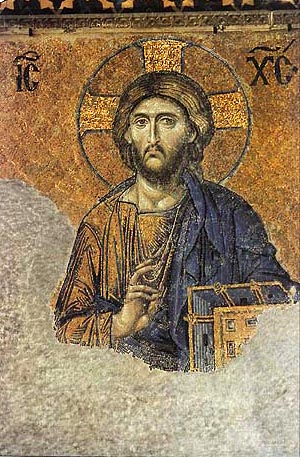 |
|
|
|
|
|
|
|
|
|
|
|
 发表于 14-12-2007 12:49 AM
|
显示全部楼层
发表于 14-12-2007 12:49 AM
|
显示全部楼层
|
|
|
|
|
|
|
|
|
|
|
 发表于 14-12-2007 12:58 AM
|
显示全部楼层
发表于 14-12-2007 12:58 AM
|
显示全部楼层
|
|
|
|
|
|
|
|
|
|
|
 发表于 14-12-2007 01:03 AM
|
显示全部楼层
发表于 14-12-2007 01:03 AM
|
显示全部楼层
http://www.mondovista.com/jesus/index.html
Nicholas Notovitch and the "Jesus Thangka" by Terry Anthony Part 1 In the summer of 2001, I took a friend of mine to see a Himalayan arts dealer I had patronized since the 1980's. I'd been purchasing Himalayan bowl gongs (more commonly known as Tibetan singing bowls) from him for 15 years or so, and my friend wanted my help in obtaining a good one for himself. Among the 20 or so examples the dealer had in stock there was one fine old example with exceptional tone which my friend purchased. While we were examining the bowls, the dealer brought out a few other items to show me. He knew I was always interested in unusual items, so he showed me what he called, "the most unusual thangka I have ever seen." He'd been traveling to the Far East each year for over 20 years bringing back such items and had seen countless antique thangkas, so I knew that statement meant something. 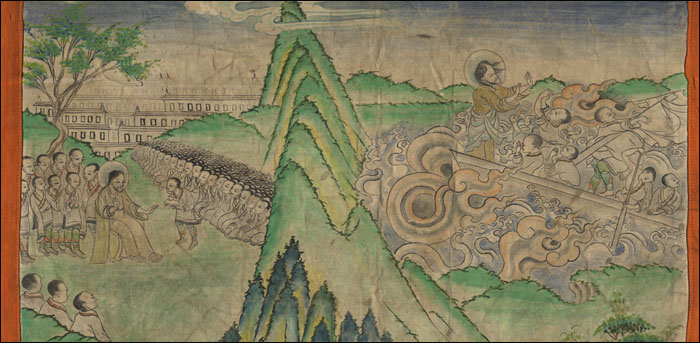 [Above: Full panel of the tapestry showing two scenes from the life of Jesus.] [Above: Full panel of the tapestry showing two scenes from the life of Jesus.] 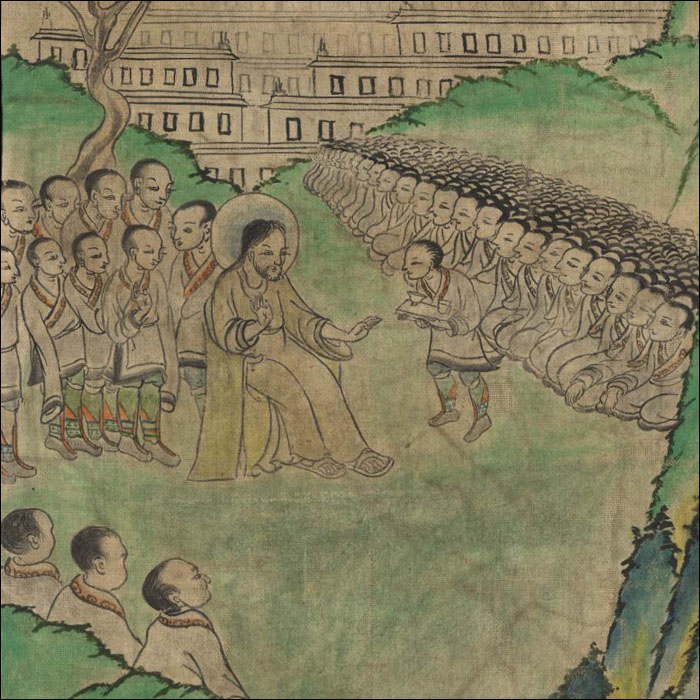 [Left: Left panel in detail. Note the scars in hands of Jesus.] [Left: Left panel in detail. Note the scars in hands of Jesus.] 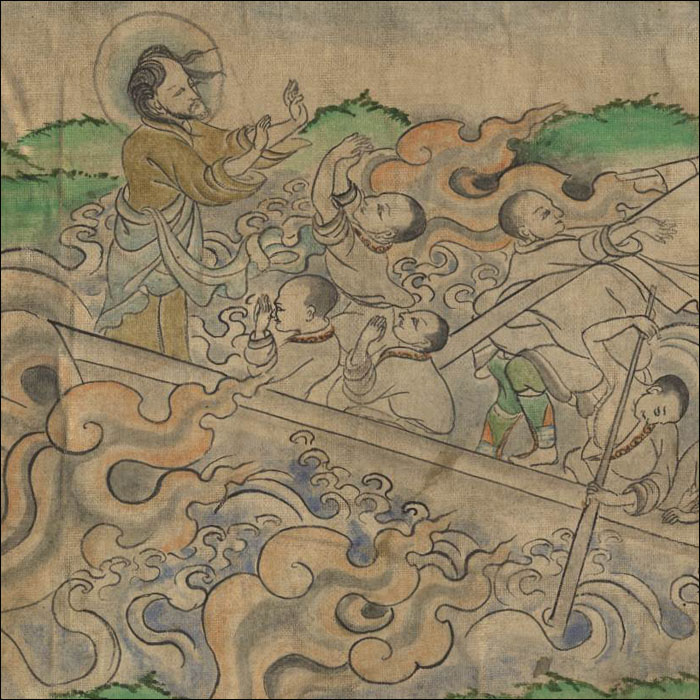 [Above: Figure 1 Right of panel in detail. Jesus walks on the water.] A thangka (pronounced with the h silent) is the traditional form of religious painting produced by Buddhist monks for centuries in the Himalayas. They are usually painted on canvas or cotton cloth and framed in silk. The old ones are commonly worn, torn, faded, stained, and just generally beaten up by years of travel by caravan from one monastery to another, though some apparently never left their original monastery, or travelled little, so are in better condition. [Above: Figure 1 Right of panel in detail. Jesus walks on the water.] A thangka (pronounced with the h silent) is the traditional form of religious painting produced by Buddhist monks for centuries in the Himalayas. They are usually painted on canvas or cotton cloth and framed in silk. The old ones are commonly worn, torn, faded, stained, and just generally beaten up by years of travel by caravan from one monastery to another, though some apparently never left their original monastery, or travelled little, so are in better condition.
[ 本帖最后由 mahalwin 于 14-12-2007 01:04 AM 编辑 ] |
|
|
|
|
|
|
|
|
|
|
|
 发表于 14-12-2007 01:03 AM
|
显示全部楼层
发表于 14-12-2007 01:03 AM
|
显示全部楼层
Part 2 This one, in fair condition, at first appeared a typical example until I took a closer look. "Looks like Jesus", I said. "Or someone who looks like Jesus", he said with a physical start, almost interrupting me. He was suddenly agitated, and we debated the point for awhile. He appeared unable to accept what was obvious to me and I finally asked if it was for sale. He said it was, so I bought it on the spot. He almost seemed relieved to be rid of it. The work consists of six scenes or "teaching story" images taken from the life of a known "avatar" or "worthy master". Such works commonly focus on the Buddha, local Himalayan religious personalities, Indian masters, or other Asian religious notables. 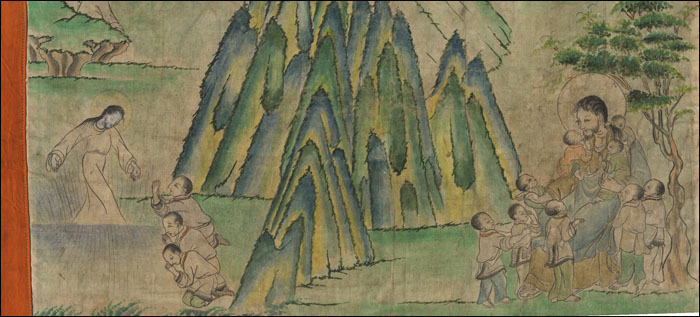 [Above: Full panel of the tapestry showing two scenes from the life of Jesus.] [Above: Full panel of the tapestry showing two scenes from the life of Jesus.] 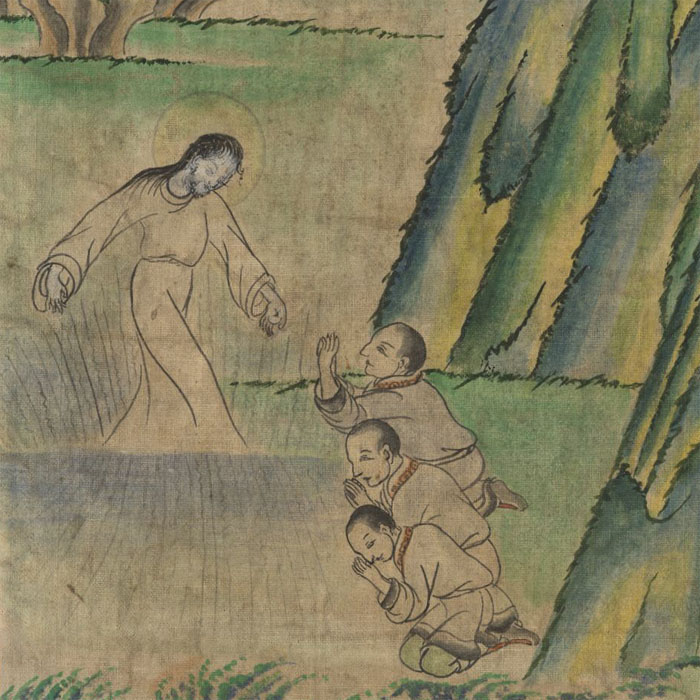 [Left: Figure 5 Left panel in detail. The transfiguration of Jesus.] [Left: Figure 5 Left panel in detail. The transfiguration of Jesus.] 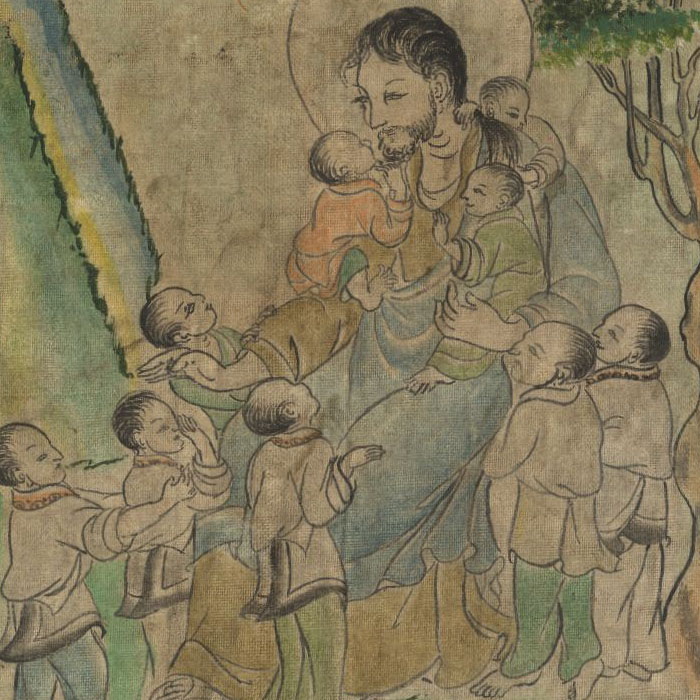 [Above: Figure 2 Right of panel in detail. Jesus with the children.] This may be the only known pre-Chinese conquest thangka of a teacher from the Middle East. Two or three thangkas of Jesus have been produced in recent years, one actually commissioned by the Dalai Lama. The scenes, five of six being obviously biblically referenced, moving clockwise beginning with the upper right scene, are as follows: 1. "Jesus calms the storm", Luke 8: 22-25, Mark 4: 35-41, Matthew 8: 23-27. 2. "Jesus with the little children", Luke 18: 15-17, Mark 10: 13-16, Matthew 19: 13-15. 3. "Jesus enters Jerusalem", Luke 19: 29-44, Mark 11: 1-11, Matthew 21: 10-11 & 14-17, John 11: 55, 12: 1, & 12: 12-19. 4. "Jesus, Mary, and Martha", Luke 10: 38-42. 5. "The Transfiguration", Matthew 17: 1-8, Mark 9: 2-10. 6. "Jesus in the Himalayas?" Obviously not from the Christian Bible. The central figure in the painting appears to be the Himalayan mountains themselves. This in itself, I believe, is unique among old thangkas. These paintings were created by monks or "lamas" as religious acts along strict guidelines. This one may have been painted by a monk familiar with the Moravian Christian missionaries who established themselves in the Himalayan region by the late nineteenth century. [Above: Figure 2 Right of panel in detail. Jesus with the children.] This may be the only known pre-Chinese conquest thangka of a teacher from the Middle East. Two or three thangkas of Jesus have been produced in recent years, one actually commissioned by the Dalai Lama. The scenes, five of six being obviously biblically referenced, moving clockwise beginning with the upper right scene, are as follows: 1. "Jesus calms the storm", Luke 8: 22-25, Mark 4: 35-41, Matthew 8: 23-27. 2. "Jesus with the little children", Luke 18: 15-17, Mark 10: 13-16, Matthew 19: 13-15. 3. "Jesus enters Jerusalem", Luke 19: 29-44, Mark 11: 1-11, Matthew 21: 10-11 & 14-17, John 11: 55, 12: 1, & 12: 12-19. 4. "Jesus, Mary, and Martha", Luke 10: 38-42. 5. "The Transfiguration", Matthew 17: 1-8, Mark 9: 2-10. 6. "Jesus in the Himalayas?" Obviously not from the Christian Bible. The central figure in the painting appears to be the Himalayan mountains themselves. This in itself, I believe, is unique among old thangkas. These paintings were created by monks or "lamas" as religious acts along strict guidelines. This one may have been painted by a monk familiar with the Moravian Christian missionaries who established themselves in the Himalayan region by the late nineteenth century. 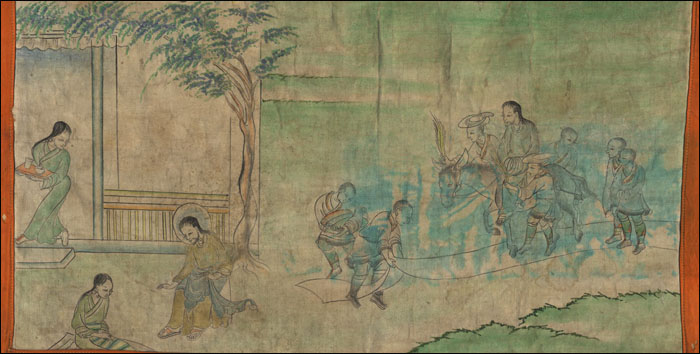 [Above: Full panel of the tapestry showing two scenes from the life of Jesus.] [Above: Full panel of the tapestry showing two scenes from the life of Jesus.] 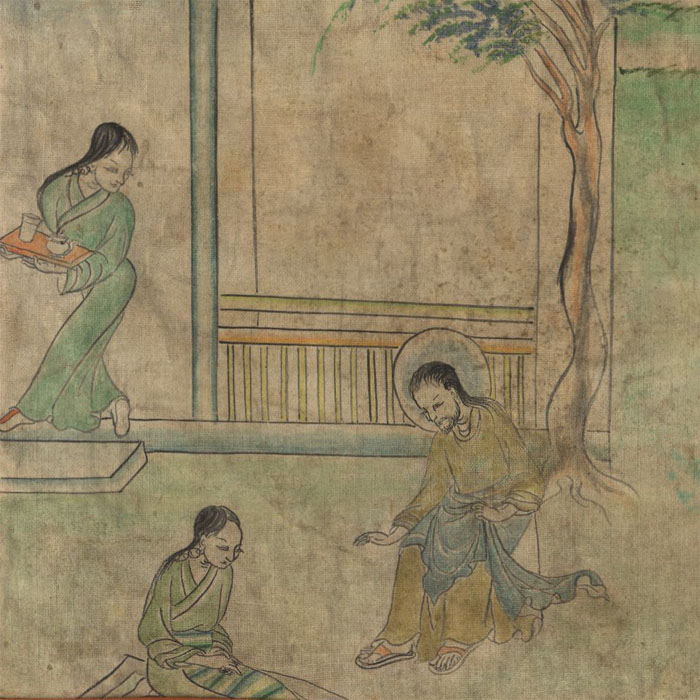 [Left: Figure 4 Left panel in detail. Jesus, Martha and Mary.] [Left: Figure 4 Left panel in detail. Jesus, Martha and Mary.]  [Above: Figure 3 Right of panel in detail. Jesus enters Jerusalem.] Whoever it was, he knew some classic Bible stories. I wish to stress that "teaching story" thangka scenes were of traditionally known religious stories. It's difficult to imagine a monk getting away with fatuous or imagined imagery. [Above: Figure 3 Right of panel in detail. Jesus enters Jerusalem.] Whoever it was, he knew some classic Bible stories. I wish to stress that "teaching story" thangka scenes were of traditionally known religious stories. It's difficult to imagine a monk getting away with fatuous or imagined imagery. |
|
|
|
|
|
|
|
|
|
|
|
 发表于 14-12-2007 01:04 AM
|
显示全部楼层
发表于 14-12-2007 01:04 AM
|
显示全部楼层
|
|
|
|
|
|
|
|
|
|
|
 发表于 14-12-2007 01:04 AM
|
显示全部楼层
发表于 14-12-2007 01:04 AM
|
显示全部楼层
Part 3 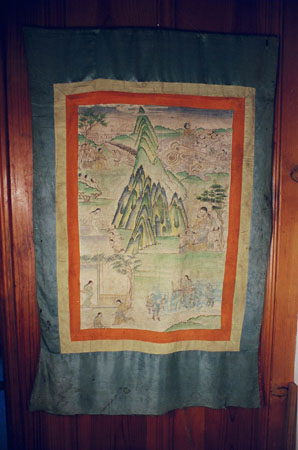 [Right: The complete thangka tapestry owned by the author.] So what are we to make of the upper left scene? It appears to suggest some historical event involving Jesus of Nazareth appearing before a couple hundred individuals or monks near a building which clearly evidences the traditional architecture of a Himalayan "gompa" or monastery. The other "biblical" scenes have many medieval to modern painted and sketched counterparts. Just google "Jesus calms the storm" or any of the others and you'll see what I mean. They are easy to identify. This upper left scene is completely anomalous. It appears to suggest a tradition of Jesus visiting some Himalayan religious center. So now we come to the Notovitch controversy. Nicholas Notovitch was a Russian journalist who travelled through the Himalayan region in the 1870's as part of a trip "through the orient" to learn about Far Eastern culture and religion and to see the sights. At some point he fell from his horse and broke a leg. While convalescing in the monastery at Hemis he claimed he was shown old manuscripts, copied from ancient ones in a library at Marbour near Lahsa, which told the story of a great foreign teacher that had travelled from the Middle East to India and the Himalayas named Issa. Upon returning from his trip he wrote a book about his discovery which included a translation of the manuscripts. If you read that translation or the later ones made by Nicholas Roerich or Swami Abhedananda, it will be clear to you that this Issa was indeed Jesus and no other. There are many accountings, discussions, and critiques of the Notovich material on the web. Some are pretty silly. I recommend this web page: http://www.tombofjesus.com/indon ... p1.htm#introduction, and its following pages, for one of the few intelligent accounts of the evidence of Nicholas Notovitch's tale and the "Jesus in India" stories. It's the only one I know that presents a good accounting of the evidence which quite overwhelms the emotional attacks of the critics. Vitriolic, emotional attacks are always suspect for me anyway. The apparent fact that westerners are no longer able to locate these Himalayan scriptures is troubling. I believe they haven't been seen since 1939, and this is seen by some as evidence that they never existed. But what about this "Jesus thangka", which by appearance (if you see it in person at least) certainly dates from the nineteenth century or earlier? [Right: The complete thangka tapestry owned by the author.] So what are we to make of the upper left scene? It appears to suggest some historical event involving Jesus of Nazareth appearing before a couple hundred individuals or monks near a building which clearly evidences the traditional architecture of a Himalayan "gompa" or monastery. The other "biblical" scenes have many medieval to modern painted and sketched counterparts. Just google "Jesus calms the storm" or any of the others and you'll see what I mean. They are easy to identify. This upper left scene is completely anomalous. It appears to suggest a tradition of Jesus visiting some Himalayan religious center. So now we come to the Notovitch controversy. Nicholas Notovitch was a Russian journalist who travelled through the Himalayan region in the 1870's as part of a trip "through the orient" to learn about Far Eastern culture and religion and to see the sights. At some point he fell from his horse and broke a leg. While convalescing in the monastery at Hemis he claimed he was shown old manuscripts, copied from ancient ones in a library at Marbour near Lahsa, which told the story of a great foreign teacher that had travelled from the Middle East to India and the Himalayas named Issa. Upon returning from his trip he wrote a book about his discovery which included a translation of the manuscripts. If you read that translation or the later ones made by Nicholas Roerich or Swami Abhedananda, it will be clear to you that this Issa was indeed Jesus and no other. There are many accountings, discussions, and critiques of the Notovich material on the web. Some are pretty silly. I recommend this web page: http://www.tombofjesus.com/indon ... p1.htm#introduction, and its following pages, for one of the few intelligent accounts of the evidence of Nicholas Notovitch's tale and the "Jesus in India" stories. It's the only one I know that presents a good accounting of the evidence which quite overwhelms the emotional attacks of the critics. Vitriolic, emotional attacks are always suspect for me anyway. The apparent fact that westerners are no longer able to locate these Himalayan scriptures is troubling. I believe they haven't been seen since 1939, and this is seen by some as evidence that they never existed. But what about this "Jesus thangka", which by appearance (if you see it in person at least) certainly dates from the nineteenth century or earlier? |
|
|
|
|
|
|
|
|
|
|
|
 发表于 14-12-2007 01:09 AM
|
显示全部楼层
发表于 14-12-2007 01:09 AM
|
显示全部楼层
可能耶稣是去过印度,但学的是婆罗门的信仰,非佛教。婆罗门的信仰也是有创造神之说。
阿育王时代派遣的佛教使团,可能有把佛教传播到西亚地区。 |
|
|
|
|
|
|
|
|
|
| |
 本周最热论坛帖子 本周最热论坛帖子
|